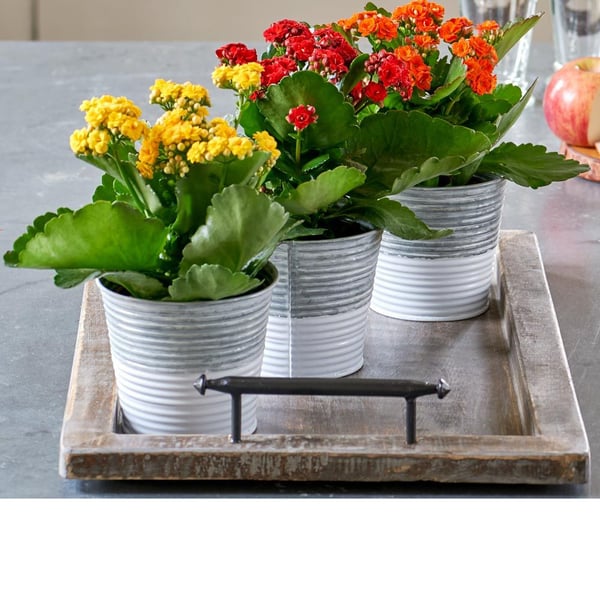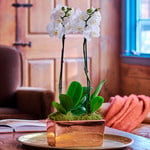How to Grow Kalanchoe

Latin Name Pronunciation: kal-en-koe'-ee
Kalanchoe is a popular succulent, often grown as a perennial houseplant. With blooms in pink, red, yellow, orange, or white, it is one of the easiest to care for flowering houseplants and can continually bloom throughout the year. It is especially popular during the fall and holiday season for its brilliant and festive colors.
Kalanchoes are easy to grow indoors in temperatures of 55°F or above. With bright indirect light, occasional watering, fertilizing, and pruning, Kalanchoe plant care is fairly easy.
Those with pets should be careful as Kalanchoe is toxic to cats and dogs. Those in USDA Zones 8-9 may grow Kalanchoe outdoors during the summer months. Plants may grow well outdoors year-round in Zones 10-11.
Light/Watering
Kalanchoe requires bright, indirect sunlight to encourage growth and blooms. Place your plants in a room with lots of natural light, but do not place them directly in a windowsill as direct sunlight can scorch leaves.
As succulents, Kalanchoe watering needs are minimal because their leaves store water. During spring and summer, saturate your Kalanchoe’s soil about once a week, or when soil is completely dry to the touch. In the fall and winter and between blooming periods, water your Kalanchoe less frequently–every other week is usually sufficient. Always allow the soil to dry out completely between waterings to prevent root rot and mildew that can harm or kill your Kalanchoe succulents. When in doubt, it is better to under-water than to over-water Kalanchoe.
Soil and Fertilizer
As with most succulents, Kalanchoe requires well-draining soil. The ideal potting mix for Kalanchoe is 60% peat moss and 40% perlite. Most mixes designed for succulents or cacti will be good for Kalanchoe. Terra cotta pots, which are known for leaching moisture from plants, are useful to help absorb any excess moisture.
Fertilize your Kalanchoe plants monthly from April-September with a water-soluble fertilizer (20-20-20) mixed at one-half the recommended strength.
Pests/Diseases
Certain fungal or bacterial infections can cause Kalanchoe plants to drop leaves. Most of these infections are caused by too much water or fertilizer and/or not enough sunlight. Black root rot (“Thielaviopsis root rot”) causes a black stem or black crack in the stem. Benzimidazole fungicides may help stop black root rot, but if the plant is severely rotted it may be best to discard it. Bacterial infections can cause soft stem rot, causing the plant to yellow and wilt. If a plant becomes infected, it is best to dispose of it.
Kalanchoe may also be affected by Powdery Mildew, a fungal disease. It is easy to recognize Powdery Mildew by the white or gray substance on the plant’s stem and/or leaves. Fortunately, it is easy to treat this disease by correcting your Kalanchoe’s care. Keep foliage dry, ensure your plant receives enough sunlight, and avoid keeping it anywhere that is excessively humid, cold, or drafty.
Common pests that may attack your Kalanchoe include spider mites, mealybugs, and scale. Spider mites are extremely small, so they may be difficult to see. The telltale signs of spider mites are white webbing on plants and speckled leaves that turn brown and dry out. Mealybugs and scale are easier to see, and can cause sticky and/or moldy leaves and leaf drop.
Remove all pests by hand or with a spray bottle, ensuring plants are allowed to dry out completely after being sprayed. If that does not work, you may need to use insecticidal soap, though this should be used with caution, especially indoors.
Pruning
Pruning your Kalanchoe will help keep it healthy and encourage new blooms. Remove dead or dying blooms immediately by trimming flower stalks to the second or third leaf. Trim dead or damaged parts of the plant using pruning shears by trimming just below where they attach to the plant. After the plant is finished blooming, cut off all flower stalks and trim stems up to a third of the way back. Make your cuts near leaf nodes, using a 45-degree angle, to encourage new stems to grow.
Dividing/Transplanting
Most Kalanchoe can remain in the same pot for years, but they will eventually need repotting. If roots are appearing over the surface of the soil, it is time to repot your Kalanchoe in a larger pot using a potting mix designed for succulents or cacti. You can divide your Kalanchoe during transplanting by gently pulling or cutting the plant apart.
Propagating
To propagate Kalanchoe, cut off a small piece of stem (about 2-3”) with 2 pairs of leaves. Remove the lower pair of leaves and let the stem harden for a few days. Once the leaf nodes have become callused, plant the stem in the same potting mix used for the main plant, covering the nodes with soil. Water your cutting, enclose it in a clear plastic bag to retain humidity, and place it in a location with bright, indirect sunlight. Within about three weeks, your cutting will become an established Kalanchoe plant, perfect for gifting or expanding your houseplant collection.
Similar Plants
Most succulents have similar care needs to Kalanchoe. Some common succulents include:
Calendar of Care
Spring
- Water every 7–10 days
- Fertilize monthly with water-soluble fertilizer (20-20-20) mixed at one-half the recommended strength.
- Prune back spent flower stalks.
- Divide or transplant, if necessary.
Summer
- Water every 7–10 days
- Fertilize monthly with water-soluble fertilizer (20-20-20) mixed at one-half the recommended strength.
- Prune back spent flower stalks.
Autumn
- Water every 1–2 weeks
- Prune stems up to one-third of the way back to encourage bushier growth
Winter
- Water every 1–2 weeks
Frequently Asked Questions
Are Kalanchoe Plants Easy To Care For?
Kalanchoe is generally very easy to care for. As long as your plant receives adequate sunlight, it has low watering and fertilization requirements. Most issues with Kalanchoe are caused by too much water or not enough light. These plants are especially forgiving to plant owners who occasionally forget to water them.
Is Kalanchoe poisonous to cats and dogs?
Yes, Kalanchoe is toxic to cats and dogs. Accidental ingestion can cause nausea, vomiting, and abnormal heart rhythm. Those with pets should keep their Kalanchoe plants out of reach.
Can Kalanchoe be Planted Outside?
Kalanchoe plants are native to Madagascar, so they can grow outdoors in any region with similar temperatures. Gardeners in USDA Zones 10 and 11 can keep Kalanchoe outdoors year-round, while those in Zones 8 and 9 may keep their Kalanchoe outdoors during the summer and bring them inside for the rest of the year.
How Long Do Kalanchoe Plants Live?
Kalanchoe plants are perennials that can live for a very long time if well-cared for.
When Does Kalanchoe Bloom?
In most parts of North America, Kalanchoe naturally blooms in March and October.
What to do with Kalanchoe After Flowering?
While some people discard Kalanchoe plants after they bloom, this is not necessary. Kalanchoe are perennial plants that will continue to bloom each spring, and provide attractive foliage when not in bloom. They can also be encouraged to bloom early or more frequently.
How to Get Kalanchoe to Rebloom
Healthy Kalanchoe will rebloom each spring. If you want your plant to bloom more frequently, you can manipulate growing conditions to force blooms. Kalanchoes develop flowers in response to changes in light typically associated with winter. Create a false winter by restricting light exposure and keeping your plant in a dark room for 12–14 hours each day, for 6–8 weeks. During this time, you can also drastically reduce the amount of water your plant receives. Once your plant begins to form flower buds, resume normal plant care.
What To Do With Leggy Kalanchoe Plant
If your Kalanchoe plant becomes leggy, it is probably not receiving enough sunlight. Move your plant to an area with bright, indirect sunlight. You may also prune back leggy growth to encourage your plant to become fuller and bushier by trimming stalks up to one third of the way back.
How Fast Does Kalanchoe Grow?
Kalanchoe plants grow rather slowly, taking 2–3 years to reach full size. They do not require frequent repotting, though they can be easily propagated from stem cuttings.





